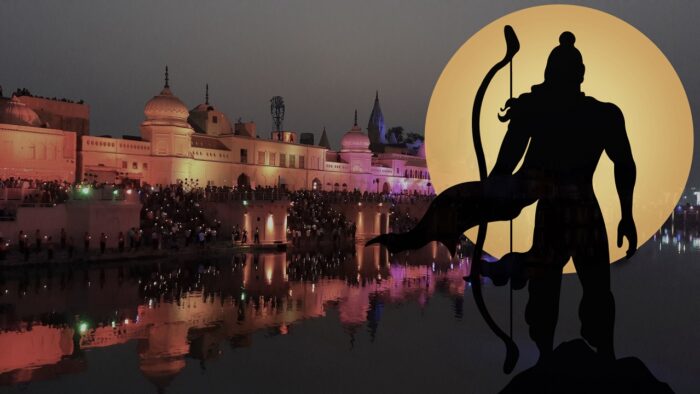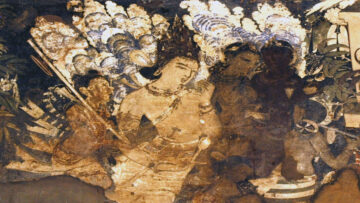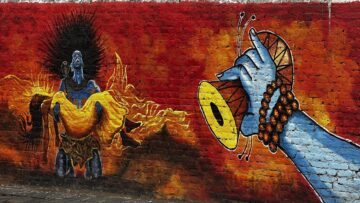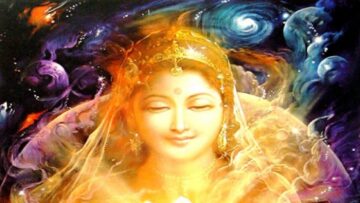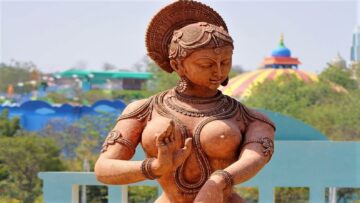As the Sun rises over the magnificent wintery horizon of Ayodhya, the gleaming rays of Dharma navigate through the weaves of the several mandapas, shikharas, gateways and passages of subtle hand-crafted sandstones, reaching the garbhagriha enshrining Shri Rama Lalla-The Infant Rama. Overshadowing the callous consequences of the past, these rays of Dharma steer graciously towards the iconic temple of infant Shri Rama in Ayodhya, with utmost honour and humility. The gorgeous Rama Lalla temple, nourished with the soil and water from numerous Hindu pilgrimages and shrines stands sturdy on the banks of the river Sarayu, amplifying the message of good over evil. The river Sarayu witnesses in affirmation, yet another piece of the bygone times being recreated, restored and rejoiced.
The initiation and progress of the Sanatan civilization have given the wise old Sarayu many fond Puranic memories and ethical lessons to whisper from one generation to another. The river recites the agony of the forbidding torrents it has survived by being a mute deserted spectator to the iconoclasm that once forcefully took away the pedestal of an ancient Puranic conviction. Today, as the cycle of time advances the same Sarayu calmly witnesses the transformation with the restitution of a forcefully demolished faith at its original dwelling vicinity. It has again established itself as an optimistic impetus to innumerable Sanatanis who stood patiently for the tide of time to undo the flaws of the past and reinstate Dharma.
The undying river Sarayu has been flowing continually along the confluence of ethical and spiritual demise and the birth of faith in the revival of moral ethos and righteousness. It has been a spectator to antiquity and modernity with its river banks and bed being the symphonic narrators of the Ramayana and its numerous illustrations, time and again. The Sarayu stands in assertion of the birth of the Sanatana faith, its existence since the long-gone times and its deep-rooted presence today. It resonates as an encyclopedia encapsulating the birth and life of Shri Rama and his brothers; the fourteen-year-long exile undertaken by Shri Rama, Devi Sita and Shri Lakshmana; their illuminated return on Deepavali to Ayodhya after the triumph over evil; the Sarayu subsequently offering its waters for the Divine Jal Samadhi of Shri Rama giving Him an exit route from the worldly affairs to his heavenly abode.
The reverberation of Shri Rama naam chanting ascertains the greatness of the Lord in all His manifestations and also establishes that of all the names attributed to Shri Vishnu, the name Rama is the most significant. The Sarayu stands by this belief as it hears Shri Rama’s name being repeated by His devotees since eternal times. According to the Puranas when the ‘Vishnu Sahasranama’- the thousand names of Shri Vishnu was shared with the mortals to get rid of their sufferings and troubles, Devi Parvati was worried as to how every human being could learn and orate the thousand names of Shri Vishnu. To this concern of Devi Parvati, Lord Shiva reveals to her the supremacy of the word Ram or Rama in the lines below as mentioned in the “Vishnu Sahasranama” enlisting the thousand names of Lord Vishnu.
श्री राम राम रामेति रमे रामे मनोरमे।
सहस्रनाम तत्तुल्यं राम नाम वरानने॥
śrī rāma rāma rāmēti ramē rāmē manōramē।
sahasranāma tat tulyaṁ rāmanāma varānanē॥
Meaning – Lord Shiva addresses Devi Parvati and tells her, O lovely-faced Lady if one chants the holy name of Rama, Rama, Rama, thus he can constantly enjoy this beautiful sound. This holy name of Shri Rama is equal to reciting one thousand holy names of Lord Vishnu. One should take pleasure and delight in the devotion and worship of Lord Rama, and constantly chant his name to attain spiritual progress.
The life force in the mighty Sarayu and the expansive spirit of the Ramayana share in common the power of sustenance through all odds in the presence of truth, friendship, love, perseverance, determination, equality, forgiveness, relationships, duty, dedication, obedience and sacrifice. It also recounts the vices including ego, arrogance, damaging company, greed, lust, revenge, disrespect and dishonesty that cause misery and the downfall of the most commanding. The prudent Sarayu upholds and unfolds every message of Shri Rama and the Ramayana to each generation that comes to its waters in search of enlightenment.
यदा यदा हि धर्मस्य ग्लानिर्भवति भारत।
अभ्युत्थानमधर्मस्यतदात्मानंसृजाम्यहम् ॥४-७॥
परित्राणाय साधूनां विनाशाय च दुष्कृताम् ।
धर्मसंस्थापनार्थाय सम्भवामि युगे युगे ॥४-८॥
yadā yadā hi dharmasya glānirbhavati bhārata।
abhyutthānamadharmasyatadātmānaṃsṛjāmyaham ॥4-7॥
paritrāṇāya sādhūnāṃ vināśāya ca duṣkṛtām ।
dharmasaṃsthāpanārthāya sambhavāmi yuge yuge ॥4-8॥
Shri Bhagavad Gita Chapter 4
Meaning – O descendant of Bharata, whenever there is the decline of Dharma and rise of Adharma, it is then that I reincarnate myself. For the protection of the good, for the destruction of the wicked, and the establishment of Dharma I come into being in every age. The Sarayu remains a reminder of the lines recited by Shri Krishna in the Bhagavad Gita.
Along with the waters of the Sarayu, Dharma also has been a constant in Ayodhya. The Sarayu remained a persistent reminder of change as it evolved over the years, and so has Dharma remained as a depiction of moral order with its universal and eternal essence. Today as we move towards upkeeping the spirit of the Sanatan Dharma, the Sarayu contributes neutrally by permitting its seekers to wash down their adversities and drift effortlessly in their sought-after path of Dharma with conviction and morality, living in harmony and peace with all.
Disclaimer: The opinions expressed in this article belong to the author. Indic Today is neither responsible nor liable for the accuracy, completeness, suitability, or validity of any information in the article.

